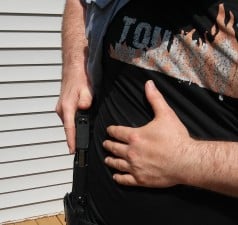New York: Fast Facts on Trespassing
- Trespass Law Covers: Buildings, Dwellings, Land, Vehicles
- Crime Class: Misdemeanor, Felony
- Fencing Required?: No, but required for protection of law for unimproved, empty land.
- Signage Required?: No, but required for protection of law for unimproved, empty land.
- Verbal Notice Required?: No, but can serve as revocation of privilege in public premises.

New York Trespassing Law Overview
- Trespass laws do not apply to any unimproved, empty land if it is not fenced or surrounded with posted signage.
- Trespassing is a violation in New York.
- 3rd and 2nd Degree Criminal Trespassing in New York is a misdemeanor.
- 1st Degree Criminal Trespassing is a felony.
Relevant New York State Statutes
- 140.00 – Criminal trespass and burglary; definitions of terms.
- 140.05 – Trespass.
- 140.10 – Criminal trespass in the third degree.
- 140.15 – Criminal trespass in the second degree.
- 140.17 – Criminal trespass in the first degree.
- 265.00 – Definitions
NY has entire sections of definitions that cover the various chapters.
It is always in your best interest to read these definitions, even if they look like ones for words that are entirely common, since a new or unexpected addition to the common meaning might change our understanding of a given passage in the law. New York’s definitions for the chapter begin in 140.00:
140.00 Criminal trespass and burglary; definitions of terms.
The following definitions are applicable to this article:
- “Premises” includes the term “building,” as defined herein, and any
real property. - “Building,” in addition to its ordinary meaning, includes any
structure, vehicle or watercraft used for overnight lodging of persons,
or used by persons for carrying on business therein, or used as an
elementary or secondary school, or an inclosed motor truck, or an
inclosed motor truck trailer. Where a building consists of two or more
units separately secured or occupied, each unit shall be deemed both a
separate building in itself and a part of the main building. - “Dwelling” means a building which is usually occupied by a person
lodging therein at night. - “Night” means the period between thirty minutes after sunset and
thirty minutes before sunrise. - “Enter or remain unlawfully.” A person “enters or remains
unlawfully” in or upon premises when he is not licensed or privileged to
do so. A person who, regardless of his intent, enters or remains in or
upon premises which are at the time open to the public does so with
license and privilege unless he defies a lawful order not to enter or
remain, personally communicated to him by the owner of such premises or
other authorized person. A license or privilege to enter or remain in a
building which is only partly open to the public is not a license or
privilege to enter or remain in that part of the building which is not
open to the public. A person who enters or remains upon unimproved and
apparently unused land, which is neither fenced nor otherwise enclosed
in a manner designed to exclude intruders, does so with license and
privilege unless notice against trespass is personally communicated to
him by the owner of such land or other authorized person, or unless such
notice is given by posting in a conspicuous manner. A person who enters
or remains in or about a school building without written permission from
someone authorized to issue such permission or without a legitimate
reason which includes a relationship involving custody of or
responsibility for a pupil or student enrolled in the school or without
legitimate business or a purpose relating to the operation of the school
does so without license and privilege.
This is a surprisingly simple and concise section when compared against much of New York’s laws. “Building” covers all kinds of structures according to its common meaning, and also large vehicles within which a person can lodge for the night.
“Premises” includes all buildings as defined above but also any real property, i.e. land, even vacant and unimproved lots. A “Dwelling” is any building which a person would typically lodge in and occupy at night.
Most interestingly and pertinent in this section is one of New York’s few exemptions to their trespassing law, found in paragraph 5 which details and defines “enter(ing) and remaining unlawfully”.
In short, you have privilege and permission to enter any public premises or building, or the portion of a public premises or building that is open to the public, but you do not have privilege when it is not open during specific hours for the public or when you are asked to leave by the owner or owner’s agent, or barred from entry by any posted notice.
Also pay particular attention to the underlined section: It is not trespassing to enter upon any empty and unused vacant land so long as that land is unfenced or otherwise unenclosed and has no posted sign barring trespassers or entry.
If you are the owner of such a parcel of land and want to keep trespassers off you will have to do one or the other to have the force of law on your side.
Next, a very short passage on simple trespassing:
140.05. Trespass.
A person is guilty of trespass when he knowingly enters or remains unlawfully in or upon premises.
Trespass is a violation.
…
If you know you shouldn’t be somewhere, and you enter that place or remain there or upon that land, you’re committing a violation in the state of New York. Not even a misdemeanor.
Next we look at criminal trespassing proper, in Section 140.10, criminal trespass in the third degree:
140.10 Criminal trespass in the third degree.
A person is guilty of criminal trespass in the third degree when he
knowingly enters or remains unlawfully in a building or upon real
property
(a) which is fenced or otherwise enclosed in a manner designed to
exclude intruders; or
(b) where the building is utilized as an elementary or secondary
school or a children’s overnight camp as defined in section one thousand
three hundred ninety-two of the public health law or a summer day camp
as defined in section one thousand three hundred ninety-two of the
public health law in violation of conspicuously posted rules or
regulations governing entry and use thereof; or
(c) located within a city with a population in excess of one million
and where the building or real property is utilized as an elementary or
secondary school in violation of a personally communicated request to
leave the premises from a principal, custodian or other person in charge
thereof; or
(d) located outside of a city with a population in excess of one
million and where the building or real property is utilized as an
elementary or secondary school in violation of a personally communicated
request to leave the premises from a principal, custodian, school board
member or trustee, or other person in charge thereof; or
(e) where the building is used as a public housing project in
violation of conspicuously posted rules or regulations governing entry
and use thereof; or
(f) where a building is used as a public housing project in violation
of a personally communicated request to leave the premises from a
housing police officer or other person in charge thereof; or
(g) where the property consists of a right-of-way or yard of a
railroad or rapid transit railroad which has been designated and
conspicuously posted as a no-trespass railroad zone.
Criminal trespass in the third degree is a class B misdemeanor.
This is another fairly straightforward section of the statutes.
If you enter or remain upon any land that is fenced or otherwise enclosed to ward off intruders, go inside the building of or on the grounds of any school facility, remain at a public housing project in violation of posted regulations governing entry or occupancy or in defiance of a request to leave, that is criminal trespassing in the third degree.
Also criminal trespassing in the third degree is illegally entering or remaining upon the posted “no trespassing” grounds of any railroad, rail yard or railway right-of-way.
Next, on to criminal trespassing in the second degree:
140.15 Criminal trespass in the second degree.
A person is guilty of criminal trespass in the second degree when:
- he or she knowingly enters or remains unlawfully in a dwelling; or
- being a person required to maintain registration under article
six-C of the correction law and designated a level two or level three
offender pursuant to subdivision six of section one hundred
sixty-eight-l of the correction law, he or she enters or remains in a
public or private elementary, parochial, intermediate, junior high,
vocational or high school knowing that the victim of the offense for
which such registration is required attends or formerly attended such
school. It shall not be an offense subject to prosecution under this
subdivision if: the person is a lawfully registered student at such
school; the person is a lawful student participant in a school sponsored
event; the person is a parent or a legal guardian of a lawfully
registered student at such school and enters the school for the purpose
of attending their child’s or dependent’s event or activity; such school
is the person’s designated polling place and he or she enters such
school building for the limited purpose of voting; or if the person
enters such school building for the limited purposes authorized by the
superintendent or chief administrator of such school.
Criminal trespass in the second degree is a class A misdemeanor.
Trespassing within any dwelling or trespassing upon any school grounds or school facility if a person is a registered sex offender under New York law (see Correctional Code article 6C for details) is a Class A misdemeanor.
Note there are lengthy exceptions for sex offenders in case they are an enrolled student at a school facility, or have a child who is a student at the facility, in this case, attending the enrolled child’s school activity or other event.
The only other exception made for sex offenders in the case of criminal trespass in the second degree is if the school is a designated polling place for that person and enters the school only for voting and nothing more.
Lastly, criminal trespass in the first degree, covered in section 140.17:
140.17. Criminal trespass in the first degree.
A person is guilty of criminal trespass in the first degree when he
knowingly enters or remains unlawfully in a building, and when, in the
course of committing such crime, he:
- Possesses, or knows that another participant in the crime
possesses, an explosive or a deadly weapon; or - Possesses a firearm, rifle or shotgun, as those terms are defined
in section 265.00, and also possesses or has readily accessible a
quantity of ammunition which is capable of being discharged from such
firearm, rifle or shotgun; or - Knows that another participant in the crime possesses a firearm,
rifle or shotgun under circumstances described in subdivision two.
Criminal trespass in the first degree is a class D felony.
Criminal trespass in the first degree is interesting only because it sounds much more akin to the definition of burglary in many other states.
Nonetheless, criminal trespass in the first degree occurs when a person unlawfully enters a building and in the course of committing another crime inside the building has on or about their person a deadly weapon or a firearm (with ammunition) or knows that another participant in that same crime possesses a firearm with ammunition readily available.
Criminal trespass in the first degree is a Class D felony in the state of New York.
The accompanying legal definitions for various firearms and deadly weapons applicable to this section are below. Read them!
New York is a state with notoriously draconian weapons laws, so you don’t want to get tarred and feathered over carry of a simple pocket knife when, as far as the law is concerned, it is a deadly weapon:
§ 265.00 Definitions.
- “Firearm” means (a) any pistol or revolver; or (b) a shotgun having
one or more barrels less than eighteen inches in length; or (c) a rifle
having one or more barrels less than sixteen inches in length; or (d)
any weapon made from a shotgun or rifle whether by alteration,
modification, or otherwise if such weapon as altered, modified, or
otherwise has an overall length of less than twenty-six inches; or (e)
an assault weapon. For the purpose of this subdivision the length of the
barrel on a shotgun or rifle shall be determined by measuring the
distance between the muzzle and the face of the bolt, breech, or
breechlock when closed and when the shotgun or rifle is cocked; the
overall length of a weapon made from a shotgun or rifle is the distance
between the extreme ends of the weapon measured along a line parallel to
the center line of the bore. Firearm does not include an antique
Firearm.
…
- “Switchblade knife” means any knife which has a blade which opens
automatically by hand pressure applied to a button, spring or other
device in the handle of the knife. - “Gravity knife” means any knife which has a blade which is released
from the handle or sheath thereof by the force of gravity or the
application of centrifugal force which, when released, is locked in
place by means of a button, spring, lever or other device.
5-a. “Pilum ballistic knife” means any knife which has a blade which
can be projected from the handle by hand pressure applied to a button,
lever, spring or other device in the handle of the knife.
…
5-c. “Automatic knife” includes a stiletto, a switchblade knife, a
cane sword, a pilum ballistic knife, and a metal knuckle knife.
5-d. “Undetectable knife” means any knife or other instrument, which
does not utilize materials that are detectable by a metal detector or
magnetometer when set at a standard calibration that is capable of
ready use as a stabbing or cutting weapon and was commercially
manufactured to be used as a weapon.
…
- “Rifle” means a weapon designed or redesigned, made or remade, and
intended to be fired from the shoulder and designed or redesigned and
made or remade to use the energy of the explosive in a fixed metallic
cartridge to fire only a single projectile through a rifled bore for
each single pull of the trigger. - “Shotgun” means a weapon designed or redesigned, made or remade,
and intended to be fired from the shoulder and designed or redesigned
and made or remade to use the energy of the explosive in a fixed shotgun
shell to fire through a smooth bore either a number of ball shot or a
single projectile for each single pull of the trigger.
…
*14. “Antique firearm” means:
Any unloaded muzzle loading pistol or revolver with a matchlock, flintlock, percussion cap, or similar type of ignition system, or a pistol or revolver which uses fixed cartridges which are no longer available in the ordinary channels of commercial trade.
How to Obtain a Trespassing Order in New York
To obtain an order of no trespass against someone in New York, you’ll need to contact your local police department or sheriff’s department as applicable. Note that proper notice against trespassing and signage in particular is very important for getting someone trespassed in New York, so make sure you check out the next section.
Rules for Posting No-Trespassing Signs in New York
New York law requires that specific notice be given against trespassing assuming you want the full backing of the law in some cases. Specifically, empty and obviously unused land must be enclosed or be posted if you want protection from trespassers.
Other than that, New York state law doesn’t specify any requirements for the signs themselves, so long as they’re posted in a way to be conspicuously noticeable to would-be trespassers. I recommend you make sure such signs are in good shape, highly visible and large enough so someone could not claim they were not seen.
Conclusion
New York’s trespassing laws are fairly compact and easy to understand, a major surprise for a state that is renowned for having loads of laws and an invasive mentality when it comes to curbing citizens’ rights.
The only curveballs are a requirement that empty and unused land be fenced or have posted signage to have protection from trespassing through the law, and reserving the worst grade of criminal trespassing for those who commit crimes while trespassing and also carry weapons.

Tom Marlowe practically grew up with a gun in his hand, and has held all kinds of jobs in the gun industry: range safety, sales, instruction and consulting, Tom has the experience to help civilian shooters figure out what will work best for them.

The tresspassing law on land with just 1 sign on a tree and a person cuts down trees, is that 1st degree under New York law
An open(non-fenced) NYPD parking lot, who is the owner? You said, when you are asked to leave by the owner or owner’s agent, who exactly would that be?
How do you get the police to ticket or at the least take a report when they refused to because kids are underage? I saw the NYS court website states they are supposed to ticket/arrest and they flat out refused to. These kids came onto our property kicking my door when I refused to answer the doorbell. When I did the mother was with them directing them to verbally abuse us. My 85 year old mother was terrified as was my autistic daughter whom these kids menace all the time.